We are now entering the final stage of Gotham Calling’s mega-list of Cold War cinema… and we are firmly in Reaganite territory, including an obsession with foreign intervention along with a vigorous resurgence of nuclear panic.
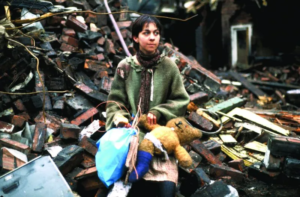
101. Threads (UK, 1984)
Let’s start with a very, very different approach to apocalyptic nightmares than those of the last post. This is the most violent – and certainly the most maximalist – of the early 1980s’ cycle of realistic docudramas drawing on cutting-edge nuclear and social sciences to present a credible speculation about the effects of an atomic exchange (a la The Day After and Testament). Threads starts off as a low-key kitchen sink TV movie about Sheffield’s working class paying little attention to an international crisis brewing over Iran until it gradually (and literally) blows up in their face… and then the film just keeps going and going, relentlessly envisioning the breakdown and possible evolution of society in fiercely uncompromising terms.

102. Top Secret! (USA, 1984)
I’ve written before about this absurdist comedy in which a version of Elvis Presley gets entangled in foreign intrigue during a trip to East Germany, spoofing the spy genre while throwing in a bunch of further oddball references (from The Blue Lagoon to The Wizard of Oz). As I mentioned at the time, the movie ‘derives most of its gags from playing with cinematic language in general (constantly subverting typical shots, sounds, and editing in unexpected ways), including a remarkable scene at a Swedish bookshop shot backwards (because everyone knows backwards English sounds just like Swedish!). Yet there is an additional meta element that arises precisely from […] amalgamating WWII and the Cold War (not only do the East Germans dress like Nazis, at one point Elvis joins the French Resistance… in the GDR!). The result places Hollywood propaganda in a continuum, ultimately mocking its long tradition of caricatural approaches to international politics, but also paying homage to the industry’s willingness to throw good taste and logic out the window in the name of thrilling fun.’ (One of the co-writers and co-directors, Jim Abrahams, went on to do Hot Shots! and its sequel, which hilariously spoofed two epitomes of what has been labelled Reaganite ‘warnography’: Top Gun and Rambo III.)
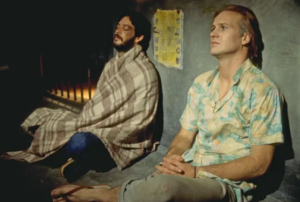
103. Kiss of the Spider Woman (USA/Brazil, 1985)
Just to jarringly shift gears once again, here is an intimate, bottom-up perspective of the Cold War as experienced, not by larger-than-life heroes, but by those who nevertheless had to make brave choices every day. In Brazil, one of the many right-wing dictatorships fostering – and fostered by – the anti-communist crusade, we zoom in on a prison where a flaming homosexual entertains his cell mate – a macho Marxist political prisoner – by recounting old movies (you know I’m a sucker for stories about the power of imagination…). And no, despite the title, Kiss of the Spider Woman does not feature Jessica Drew.
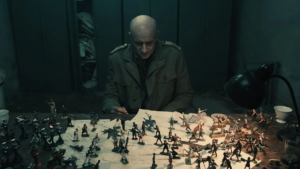
104. O-Bi, O-Ba: The End of Civilization (Poland, 1985)
The West had no monopoly on soul-crushing post-apocalyptic fiction, as seen in Czechoslovakia’s minimalist Late August at the Hotel Ozone or the USSR’s sepia-tinged Dead Man’s Letters. In fact, Eastern Bloc filmmakers used futuristic dystopias to work around censorship and comment on current politics, making a case for peace while visualizing the destruction of their respective countries. My favorite of this lot is O-Bi, O-Ba: The End of Civilization, about a community of survivors of nuclear war stuck in a decrepit shelter and trying to remain sane while clinging to the hope of being saved from the surrounding radioactive fallout. It’s a majestic piece of neon-lit sci-fi surrealism whose themes are simultaneously universal (faith, social control, state propaganda) and allegorical of Poland’s own authoritarian regime falling apart. (Writer-director Piotr Szulkin had already pulled a similar trick a few years before, with The War of the Worlds: Next Century, a twist on H.G. Well’s classic that doubled as a satire of Soviet occupation and subsequent dictatorship, but that one was so blatant that it got immediately banned.)
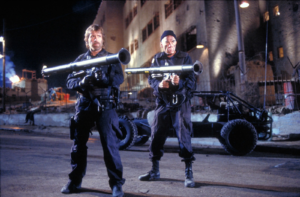
105. The Delta Force (USA/Israel, 1986)
I guess I should include at least one of Cannon’s B-movies starring Chuck Norris, whose reactionary politics put Red Dawn to shame (and which apparently were quite popular in Romania, via smuggled, dubbed VHS tapes). And since this was also a time of airplane hijackings, post-Carter reaffirmation of US might, and rampant Islamophobia, I might as well go with The Delta Force, which is a fascinating picture on multiple levels. One layer of propaganda urges for a tough-on-terror policy through an alt-history of the highjack of flight TWA 487, recreated, up to a point, in almost docudrama detail (but with the terrorists now led by Robert Forster in brownface). In this timeline, US special forces, still frustrated over the failed Operation Eagle Claw (in Iran), instead of leaving it up to politicians to negotiate a solution, sneak into the Middle East to kick some ass. A second layer has to do with Israel, where the movie was shot (and whose IDF supported the production), with writer-director-producer Menahem Golan presenting his country as an example (especially Operation Entebbe) and as a strategic ally in the fight against a common enemy, namely clichéd Muslim Arabs shown as cruel fanatics threatening sympathetic passengers from other religions, particularly Jews (a simplistic narrative that continues to resonate uncritically in many people’s imagination, with devastating effects… and which has somehow become even more tragic and revolting in these past few months). As manipulative and racist as it is, Delta Force’s first half nevertheless delivers a taut, tense Airport-style disaster drama (it even features George Kennedy!), including shameless – yet still effective – references to the Holocaust… And then the second half gleefully embraces such cartoony violence (Norris rides a super-motorcycle!) that one wonders if the filmmakers were more committed to their hawkish agenda or to the joy of blasting the screen with slam-bang action over a catchy soundtrack. The display of fighting skills and technology is surely meant to instill a form of gung-ho catharsis, but the result can be baffling: at one point, near the end, there is a mano-a-mano combat that feels so disproportionate that it’s almost as if they’re teasing you to root for the underdog villain. That said, don’t doubt for a moment that the picture will end on the schmaltziest of notes!
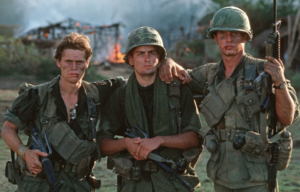
106. Platoon (USA, 1986)
The best companion piece to Apocalypse Now is not the string of right-wing revisionist movies about betrayed POWs (the likes of Missing in Action and Rambo II), but rather this more autobiographic approach to the experience of US soldiers in the Vietnam War, written and directed by a veteran clearly struggling with his own ghosts. Instead of Martin Sheen, this time it’s his son Charlie who serves as our entry point into the struggle for the US soul being fought in the jungles near the Cambodian border… The atmosphere and action are just as immersive in their own way, yet Platoon oozes authenticity and treats its characters as actual human beings rather than operatic figures in a grandiose epic.
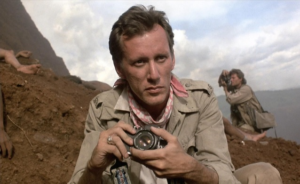
107. Salvador (USA, 1986)
The manic foreign correspondent Richard Boyle (a slimy weasel if there ever was one) travels to 1980 El Salvador and finds a manic place (one of the most terrifying pits of violent chaos ever committed to the screen) in this manic film, revealingly set against the backdrop of Ronald Reagan’s first presidential election. With righteous anger, a fair amount of sadism, and not without racism, Salvador rubs in viewers’ eyes the viciousness of the very bloody civil war (treated as a ‘proxy war’ by Washington) and the notorious death squads of the US-backed military dictatorship. Like Under Fire (which I recommended weeks ago), this movie looks into the recent tragic past of Central America through the eyes of a journalist (the real-world Boyle co-wrote the script), yet it’s more ruthless in denouncing the ignorance and acquiescence of the press and, ultimately, of the public itself: along with Platoon, this is part of Oliver Stone’s one-two punch to US foreign policy via the lost naiveté of North-Americans acknowledging their brutal role in the Third World.

108. No Way Out (USA, 1987)
It seems like No Way Out’s protagonist can’t catch a damn break: not only does he get involved with the lover of the Secretary of Defense, he also gets embroiled in a murder *and* in an investigation into a mole at the Pentagon. This horny, labyrinthine mix of sex and political intrigue cleverly updates classic Hitchcockian trappings as filtered by the conspiracy thrillers of the 1970s and seasoned with a generous pinch of its era’s cynicism. And what an ending!
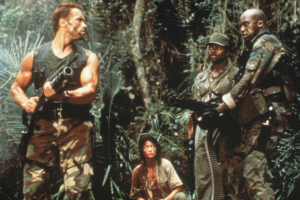
109. Predator (USA, 1987)
Two awesome Cold War movies for the price of one. The first part of Predator, which follows a full-on military mission carried out by a US rescue team who gradually suspect they’re getting embroiled in someone else’s dirty op, is packed with references to real-world conflicts. The rest of the film veers into sci-fi adventure/horror territory, but it provides its own geopolitical echoes in the form of a grisly life-or-death fight against a terrifying adversary hiding in the Central American jungle. Damn quotable.
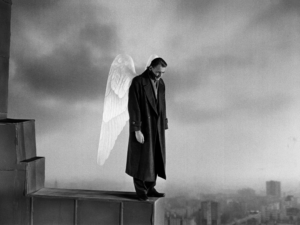
110. Wings of Desire (West Germany/France, 1987)
Melancholic, quasi-plotless until the final stretch, and (mostly) shot in gorgeous black & white, Wings of Desire is an extended mood piece that follows a couple of angels in West Berlin voyeuristically gazing into people’s inner thoughts and personal dramas (and into concerts by Nick Cave & the Bad Seeds). Besides providing a beautifully immersive experience if you’re in a contemplative frame of mind, the film belongs on this list for the way it portrays divided Berlin as a resigned status quo: the Wall has been integrated into the city’s sadness, but there’s hardly any overt anticipation that in just a couple of years people will actively tear it down. Then again, the angels’ free movement is obviously an enduring fantasy of freedom and circulation… and this proto-fairytale does involve separate entities ultimately coming together, as suggested by Solveig Dommartin’s haunting monologue near the end. (Wim Wenders did an underwhelming sequel a few years after the fall of the Wall, Faraway, So Close!)
